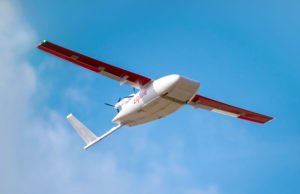
It’s a bold statement, but at the Commercial UAV Expo in Las Vegas, French made the point that medical drone delivery democratizes access to supplies all around the world.
“There are many communities that lack access to vital supplies,” says French, pointing out that lack of road infrastructure, limited supply, or perishability all contribute to difficulties in fair distribution of medical supplies like the blood products, vaccine supplies, and more that Zipline delivers across countries in Africa today. “These disparities have very real health and societal costs, and we developed Zipline to help solve those problems.”
Zipline isn’t only working in developing countries: this year the company begins trials in the U.S. Anywhere that Zipline and drone delivery operate, says French, there is the opportunity to expand distribution without additional noise, pollution, road traffic, or collisions.
The U.S. Regulatory Environment vs. International Developments
Asked how the U.S. regulatory environment compared to the international landscape – and whether or not the U.S. was maintaining a leadership position in aviation – French indicated that that U.S. regulators would start shifting the way that they evaluate the risk of drone operations.
“The bottom line is that safety is the first priority – full stop,” says French. “… but based on our learnings, we would challenge the US to learn from some of these other countries. America needs to look at the whole picture of wheter a UAS program makes a community safer or not – this is the only way to determine if an operation is in the public interest.”
French also points out that in order to get the necessary data to accurately assess safety and inform regulations, drones need to be allowed to fly. “Solving real problems for Americans is going to give us the feedback that we need to determine the value of a program,” he says. “We’re seeing other countries make quick steps to benefit their citizenry: in the U.S., we’re using a framework designed around passenger jets that weigh thousands of pounds and carry hundreds of people…We need to stop using a regulatory framework that was designed for a 747 for a 40 pound styrofoam aircraft flying a fixed route. These have fundamentally different risk profiles.”
“We need to start to compare the benefits and the risks of UAS with the benefits and risk of the status quo…. We can’t really afford to wait years for rules to take affect. It takes a committment for us to demand bolder results. Our communities are counting on us.”

Miriam McNabb is the Editor-in-Chief of DRONELIFE and CEO of JobForDrones, a professional drone services marketplace, and a fascinated observer of the emerging drone industry and the regulatory environment for drones. Miriam has penned over 3,000 articles focused on the commercial drone space and is an international speaker and recognized figure in the industry. Miriam has a degree from the University of Chicago and over 20 years of experience in high tech sales and marketing for new technologies.
For drone industry consulting or writing, Email Miriam.
TWITTER:@spaldingbarker
Subscribe to DroneLife here.